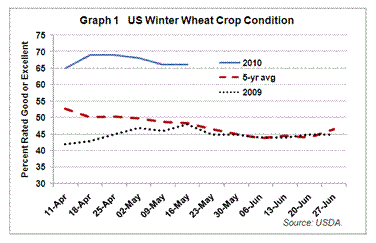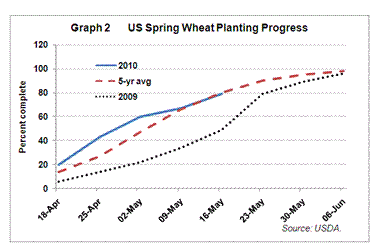
North American Crop Update
- Tuesday May 25, 2010
This analysis featured in the May 25, 2010 issue of the HGCA's MI Prospects, Volume 12, Issue 23
Key Points
North American planting and early crop development conditions have been good. In the US, the winter wheat crop is in exceptionally good condition. Spring crop sowing has been earlier than normal and crops have generally good moisture reserves to work off.
US
The first USDA survey-based winter wheat production estimate placed the 2010 crop at 39.7Mt, 4% below the 2009 crop with area down 8% and yield up 4%. The condition of the crop is in aggregate as good as it has been in many years with 66% of the USDA's crop reporters rating it as good or excellent as of May 23. This compares with a five-year-average of 45% and a ten-year range of 34 to 58% (Graph 1).
continue
It has been wetter than usual just about everywhere that matters with the consequence of green crops. Moisture conditions in Texas and Oklahoma have been particularly good and crops in these two states look exceptionally well. It is mainly because of the conditions in these two states that overall US winter wheat condition did not decline as it normally does between autumn and spring.
The Hard Red Winter wheat (HRW) crop, grown mainly in the Great Plains states west of the Mississippi River, is in fact estimated up 5% as a result of much improved yield prospects over last year. In the Soft Red Winter wheat (SRW) growing states, generally east of the Mississippi, production is estimated to be down 30% with the area sown last autumn being restricted by slow maturity, and late harvest of maize and soyabeans and very wet field conditions.
Typically, the USDA's winter wheat ratings decline as crops approach maturity but there has been little evidence of this yet. The earliest US crops are harvested in the Corpus Christi area of southern Texas in late May. By late June, the US harvest is typically about 40% complete. Based on current conditions, it is thus reasonable to expect an upward revision in US winter wheat production estimates from the first survey estimate made in early May.
The USDA's prospective planting survey made in early March reported spring wheat areas of 0.9Mha for durum, down 13% from last year, and for other spring wheat of 5.6Mha, up 1%. Planting has been progressing on a par with the five-year-average and is well ahead of last year's rain / flooding delayed rate (Graph 2). While moisture conditions may not be as good as last year, there have been few reports of too dry conditions.
continue
It may be reasonable, however, to expect farmers to have planted rather more durum and less other spring wheat than was reported in the prospective planting survey. General market prospects for durum have not improved but grower benefits for durum production were enhanced in April by adjustments to the US Loan Deficiency Payment Programme. In essence, the programme provides farmers with a market subsidy equal to the difference between past year average and current market prices. This proves to be an incentive for durum this year, since durum wheat prices have been much above those for other wheat in recent years.
The USDA used a yield of 2.92 t/ha on a harvested area of 19.1Mha in its May 11 supply and demand projections, suggesting a total 2010 wheat production of 55.6Mt. However, based on current conditions, it may be reasonable to expect an increase in 2010 all wheat output projections. These are likely to be most pronounced for durum and HRW although the USDA does not normally release supply and demand data for wheat by class until June.
In contrast to last year, field work and planting of the US maize crop has been earlier than usual (Graph 3). Almost half the crop was planted in a two week period in late April. As of May 23, planting was 93% complete and two weeks ahead of normal before rain slowed progress. However, the rain benefited the two thirds of the crop that was in the ground.
continue
If there is a concern with the maize crop, it is that cooler weather has delayed growth with the potential for reduced germination. But as of May 23, 71% of the crop had germinated compared to a five-year-average of 62%. The first crop ratings were 67% good or excellent, compared with a 71% five-year-average. This year's first ratings were two weeks earlier than normal.
It is probably too early to use anything other than trend yield projections together with prospective areas to assess production potential, as the USDA does for its May Supply and Demand projections. But as has been the case for several years, anything short of favourable crop developments is likely to impact on export availability. As with maize, crop development does not provide anything beyond expectation of trend yield on prospective planting survey area.
With maize plantings ahead of normal, farmers have been able to get on with soyabeans earlier than usual. As of May 23, the USDA reported soyabeans 53% planted compared to 44% last year and a 57% five-year-average (Graph 4).
continue

Canada
In Western Canada, spring sowing has progressed favourably with much improved soil moisture following above average rain and / or snow over most of the Prairie region over the last two months. The exception is the extreme west and Peace River regions of Alberta. These have, in some cases, recently received enough moisture for germination but will require above average follow-up rain to sustain average yields.
Assuming normal rainfall, average yields are now a reasonable expectation. There is also the possibility of adjustments to areas sown by crop from those surveyed in late March when drought was a real possibility in the Western prairies. An anticipated rise in summer fallowed area similar to last year following dry sowing conditions is now unlikely to occur. The area that may otherwise have been summer fallowed is likely to be sown mainly to canola. There may also be a further swing from durum to spring wheat in view of the US support programme for durum wheat.
In Eastern Canada and particularly in the arable areas of Ontario sowing got off to a very early start with as much as 70% of crop in the ground by the end of April. This was more than two weeks ahead of normal sowing pace. Some areas have subsequently been subject to frost damage but little if any resowing will be necessary. The same cool weather has delayed soyabean planting but not yet to the degree that yields will seriously be compromised.
David Walker (001) 780 434 7615
top of page